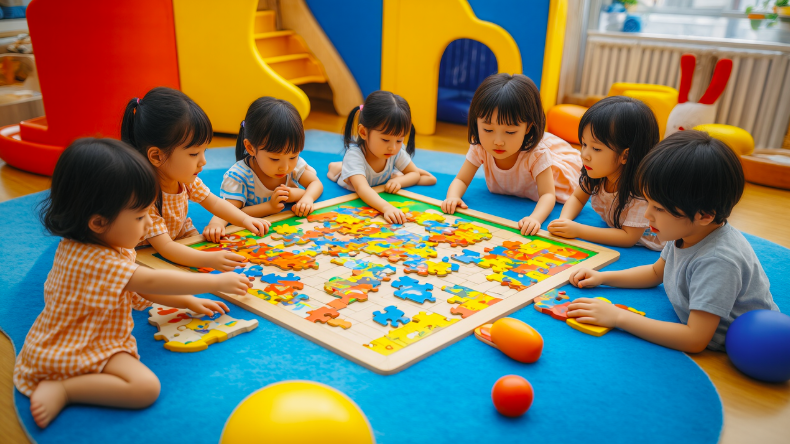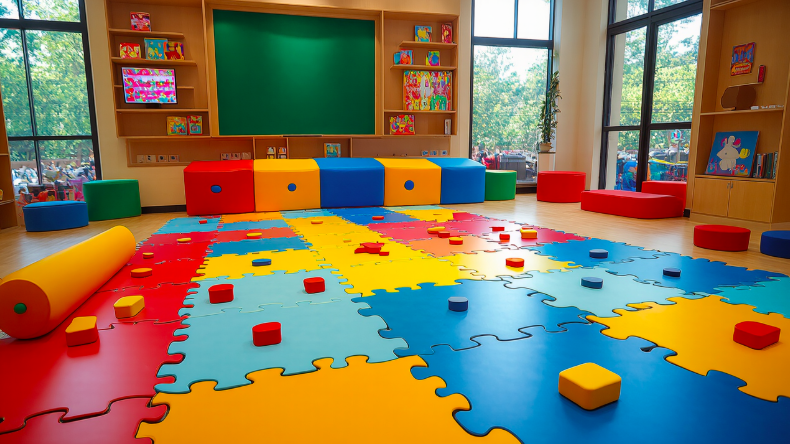Tactile Puzzle Experiences: A New Way To Play And Learn
Explore how tactile puzzle experiences improve focus, memory, and creativity through hands-on play in learning and entertainment settings.
Mar 29, 202599 Shares49.5K Views

Tactile puzzles are physical puzzles that involve touch, movement, and hand interaction. They include objects like jigsaw puzzles, wooden brain teasers, mechanical locks, and 3D puzzle boxes. These puzzles let players engage with real-world materials to solve challenges.
In a world filled with screens and digital games, tactile puzzles are gaining new popularity. People are looking for hands-on experiences that feel real and personal. The demand for physical puzzles has increased, especially in settings like board game cafés, escape rooms, and educational spaces.
Physical interaction brings something unique to puzzle-solving. It helps with focus, memory, and problem-solving skills. Touch-based learning is known to improve understanding. Moving pieces, feeling textures, and solving things with your hands adds depth to the whole experience. This is something digital games often lack.
Today, tactile puzzles are not just for children. Adults use them for brain training, stress relief, and group play. Their rise shows a strong shift toward more connected, hands-on thinking in modern game culture.
Why Tactile Engagement Enhances Puzzle Solving
Using hands while solving puzzles helps the brain work better. Studies show that when people touch and move objects, they remember things more clearly. The act of turning, sliding, or connecting pieces keeps the mind focused on the task.
Tactile puzzles also support creative thinking. Feeling the shape, weight, and texture of parts encourages the brain to explore more ways to solve problems. This kind of physical problem-solving builds stronger thinking patterns.
Research from the field of kinesthetic learning proves that many people learn better through movement. A study published in Frontiers in Psychology(2018) found that physical interaction improves learning outcomes and attention in both children and adults.
User feedback also supports this. Many puzzle fans say that tactile puzzles feel more satisfying and relaxing than digital ones. The physical effort adds a sense of progress that clicking or tapping on a screen cannot match.
Tactile engagement is not just about fun—it helps train the brain. It builds better memory, sharpens focus, and supports deeper understanding. That’s why tactile puzzle solving is becoming a favorite in both learning spaces and entertainment.
Types Of Tactile Puzzles And Their Unique Appeal
Jigsaw Puzzles
Jigsaw puzzles are one of the most popular tactile puzzle types. Players match interlocking pieces to form a picture. The appeal lies in the process of searching, sorting, and placing each piece. The cardboard texture and piece shapes make the task satisfying and hands-on.
Mechanical Puzzles
Mechanical puzzles include items like Rubik’s Cubes, metal disentanglement puzzles, and sliding tile games. These puzzles are loved for their clever designs and movement-based solving. The clicking, rotating, or shifting pieces offer a real-time sense of progress.
Wooden Logic Games
Wooden puzzles often come in the form of blocks, interlocking shapes, or 3D brain teasers. They feel natural to touch and are usually handcrafted. The smooth wood texture and smart structure make them enjoyable and calming to use. Their durability also adds to their charm.
Escape Room Props
Escape room puzzles include keys, locks, hidden compartments, and combination boxes. These physical puzzles offer real-world mystery solving. Their appeal comes from the excitement of discovery and the mix of textures like metal, plastic, and wood in one setting.
Puzzle Boxes
Puzzle boxes are objects that open only after solving a series of physical steps. They may involve sliding panels, hidden buttons, or rotations. Their charm comes from the detailed craftsmanship and the reward of unlocking something with your own hands.
Design Principles For Creating Effective Tactile Puzzles
Balance Between Challenge and Simplicity
A well-designed tactile puzzle should be challenging but not overwhelming. The goal must be clear, and the steps should make sense. If a puzzle is too hard, players lose interest. If it’s too easy, it feels boring. A balanced puzzle keeps players engaged.
Clear Feedback Through Physical Response
Tactile puzzles should give feedback through movement or sound. A click, slide, or shift tells the player they are doing something right. This feedback helps guide the next step and builds confidence during solving.
Texture Adds to the Experience
The feel of the puzzle matters. Smooth wood, cool metal, or soft rubber can change how a puzzle is enjoyed. Texture helps players connect with the puzzle and makes it easier to grip, turn, or slide parts.
Material Choice Affects Usability
Strong materials like wood, metal, or high-quality plastic make puzzles last longer. They also feel better in the hands. Good materials improve both the look and the function of the puzzle.
Clarity in Design and Layout
Every part of the puzzle should have a purpose. The layout must be clean and not overloaded with details. Clear shapes and simple structures help players focus on solving instead of guessing what to do.
Physical Design Shapes Player Perception
The size, weight, and movement of puzzle parts affect how players think about the puzzle. A heavy piece may feel more important. A hidden part may create mystery. These small design choices shape the full experience.
Tactile Puzzle Trends And The Future Of Hands-On Play
Rise of Art-Inspired Puzzles
Art-inspired jigsaw puzzles are gaining popularity, offering museum-quality contemporary art by artists of color. These puzzles provide a tactile experience that combines art appreciation with hands-on engagement.
Integration of 3D Printing
3D printing technology is enhancing the tactile experience of puzzles by enabling more complex and unique designs. This allows for rapid prototyping and production of custom puzzle pieces, enriching the hands-on interaction.
Hybrid Board Games
Hybrid board games that combine physical components with digital elements are on the rise. These games offer tactile engagement through physical pieces while integrating digital features for an immersive experience.
Puzzle Races and Social Engagement
Puzzle races, where teams compete to solve puzzles within a time limit, are becoming popular. These events often support charitable causes, adding a feel-good factor to the thrill of competition.
Inclusive Puzzle Designs
Puzzles designed to be inclusive of individuals with visual impairments are emerging. These puzzles incorporate tactile clues and textured printing technology, making hands-on play accessible to a broader audience.
Continued Demand for Tactile Puzzles
In a digital age, tactile puzzles offer a break from screens, promoting mindfulness and relaxation. Their tangible nature provides a sense of accomplishment, contributing to their enduring appeal.
🔹 FAQs: Tactile Puzzle Experiences
What are tactile puzzle experiences?
Tactile puzzle experiencesinvolve physical puzzles that require hands-on interaction, engaging the sense of touch to solve challenges. Examples include jigsaw puzzles, mechanical puzzles, and wooden logic games. These activities enhance fine motor skills and cognitive development.
How are tactile puzzles different from digital puzzles?
Tactile puzzles are physical objects that engage the sense of touch, requiring manual manipulation to solve. Digital puzzles, on the other hand, are virtual and rely on visual interaction through screens. The hands-on nature of tactile puzzles can enhance learning and memory retention.
Why do tactile puzzles feel more engaging?
Tactile puzzles engage multiple senses, particularly touch, which can enhance cognitive engagement and make the experience more immersive. The physical manipulation involved in solving these puzzles can lead to a deeper connection with the task, making it more satisfying.
What materials are best for tactile puzzle design?
Wood is a preferred material for tactile puzzles due to its durability, natural texture, and safety. Wooden puzzles are non-toxic and provide a satisfying tactile experience, making them suitable for all ages.
Are tactile puzzles good for children’s learning?
Yes, tactile puzzles are beneficial for children's learning. They help develop problem-solving skills, cognitive abilities, fine motor skills, and hand-eye coordination. Additionally, they can teach concepts such as shapes, colors, and spatial relationships.
Can tactile puzzles improve memory or focus?
Engaging with tactile puzzles can enhance cognitive functions, including memory and focus. The hands-on problem-solving process stimulates the brain, potentially improving mental functions and providing therapeutic benefits.
What are some popular types of tactile puzzles?
Popular types of tactile puzzles include jigsaw puzzles, mechanical puzzles like Rubik's Cubes, wooden logic games, and Montessori puzzle maps. Each type offers unique challenges and benefits, catering to various age groups and skill levels.
Are there puzzle games that mix digital and tactile play?
Yes, some modern games combine physical components with digital elements, creating a hybrid experience. These games integrate tactile interaction with digital feedback, enhancing engagement and learning outcomes.
How can I create my own tactile puzzle?
To create your own tactile puzzle, start by selecting durable materials like wood. Design the puzzle to match the developmental stage of the intended user, ensuring it is challenging yet solvable. Focus on creating pieces that are safe, appropriately sized, and engaging.
Are tactile puzzles making a comeback in modern games?
Yes, tactile puzzles are experiencing a resurgence as people seek hands-on, screen-free activities. Their benefits for cognitive development and the satisfying nature of physical problem-solving contribute to their renewed popularity.
Latest Articles
Popular Articles
